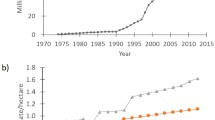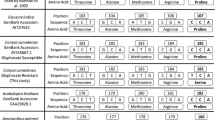Abstract
N-(phosphonomethyl)glycine (glyphosate) resistance was previously reported in a horseweed [Conyza (=Erigeron) canadensis (L.) Cronq.] population from Houston, DE (P R0 ). Recurrent selection was performed on P R0 , since the population was composed of susceptible (5%) and resistant (95%) phenotypes. After two cycles of selection at 2.0 kg ae glyphosate ha−1, similar glyphosate rates that reduced plant growth by 50%, glyphosate rates that inflicted 50% mortality in the population, and accumulations of half of the maximum detectable shikimic acid concentration were observed between the parental P R0 and the first (RS1) and second (RS2) recurrent generations. In addition, RS1 and RS2 did not segregate for resistance to glyphosate. This suggested that the RS2 population comprised a near-homozygous, glyphosate-resistant line. Whole-plant rate responses estimated a fourfold resistance increase to glyphosate between RS2 and either a pristine Ames, IA (P P0 ) or a susceptible C. canadensis population from Georgetown, DE (P S0 ). The genetics of glyphosate resistance in C. canadensis was investigated by performing reciprocal crosses between RS2 and either the P P0 or P S0 populations. Evaluations of the first (F1) and second (F2) filial generations suggested that glyphosate resistance was governed by an incompletely dominant, single-locus gene (R allele) located in the nuclear genome. The proposed genetic model was confirmed by back-crosses of the F1 to plants that arose from achenes of the original RS2, P P0 , or P S0 parents. The autogamous nature of C. canadensis, the simple inheritance model of glyphosate resistance, and the fact that heterozygous genotypes (F1) survived glyphosate rates well above those recommended by the manufacturer, predicted a rapid increase in frequency of the R allele under continuous glyphosate selection. The impact of genetics on C. canadensis resistance management is discussed.


Similar content being viewed by others
References
Anonymous (2004) Crop protection reference. C and P, New York, pp 1836–1855
Baerson SR, Rodriguez DJ, Biest NA, Tran M, You J, Kreuger RW, Dill GM, Pratley JE, Gruys KJ (2002a) Investigating the mechanism of glyphosate resistance in rigid ryegrass (Lolium ridigum). Weed Sci 50:721–730
Baerson SR, Rodriguez DJ, Tran M, Feng Y, Biest NA, Dill GM (2002b) Glyphosate-resistant goosegrass. Identification of a mutation in the target enzyme 5-enolpyruvylshikimate-3-phosphate synthase. Plant Physiol 129:1265–1275
Barry G, Kishore G, Padgette S, Taylor M, Kolacz K, Weldon M, Re D, Fincher K, Hallas L (1992) Inhibitors of amino acid biosynthesis: strategies for impairing glyphosate tolerance to crop plants. In: Singh BJ, Flores HE, Shannon JC (eds) Biosynthesis and molecular regulation of amino acids in plants. Current topics in plant physiology, vol 7. American Society of Plant Physiology, Rockville, p 386
Baylis AD (2000) Why glyphosate is a global herbicide: strengths, weaknesses and prospects. Pest Manag Sci 56:299–308
Bradshaw LD, Padgette SR, Kimball SL, Wells BH (1997) Perspectives on glyphosate resistance. Weed Technol 11:189–198
Brown SM, Whitwell T (1988) Influence of tillage on horseweed, Conyza canadensis. Weed Technol 2:269–270
Buhler DD, Owen MDK (1997) Emergence and survival of horseweed (Conyza canadensis). Weed Sci 45:98–101
Castle LA, Siehl DL, Gorton R, Patten PA, Chen YH, Bertain S, Cho HJ, Duck N, Wong J, Liu D, Lassner MW (2004) Discovery and directed evolution of a glyphosate tolerance gene. Science 304:1151–1154
Chun PT, Hickok LG (1992) Inheritance of two mutations conferring glyphosate tolerance in the fern Ceratopteris richardii. Can J Bot 70:1097–1099
Collett D (2002) Modelling binary data. CRC, Boca Raton, p 408
Cromartie TH, Polge ND (2002) Method of detecting shikimic acid. US Patent 6,482,654
Dauer JT, Humston R, Peskin N, Mortensen DA, Jones BP (2003) Predicting long-distance dispersal of horseweed (Conyza canadensis) using wind tunnel experiments (Abstract). WSSA 43:26
Duncan CN, Weller SC (1987) Heritability of glyphosate susceptibility among biotypes of field bindweed. J Hered 78:257–260
Feng PCC, Pratley JE, Bohn JA (1999) Resistance to glyphosate in Lolium rigidum. II. Uptake, translocation, and metabolism. Weed Sci 47:412–415
Feng PCC, Tran M, Chiu T, Sammons RD, Heck GR, CaJacob CA (2004) Investigations into glyphosate-resistant horseweed (Conyza canadensis): retention, uptake, translocation, and metabolism. Weed Sci 52:498–505
Foley ME (1987) Glyphosate accumulation in leafy spurge laticifers. Can J Plant Sci 67:509–510
Gardner SN, Gressel J, Mangel M (1998) A revolving dose strategy to delay the evolution of both quantitative vs major monogene resistances to pesticides and drugs. Int J Pest Manag 44:161–180
Gasquez J (1997) Genetics of herbicide resistance within weeds. Factors of evolution, inheritance and fitness. In: De Prado R, Jorrín J, García-Torres L (eds) Weed and crop resistance to herbicides. Kluwer, Dordrecht, pp 181–189
Gleason HA, Cronquist A (1991) Manual of vascular plants of northeastern United States and adjacent Canada. New York Botanical Garden, New York, p 810
Gout E, Bligny R, Genix P, Tissut M, Douce R (1992) Effect of glyphosate on plant cell metabolism. 31P and 13C NMR studies. Biochimie 74:875–882
Harring T, Streibig JC, Husted S (1998) Accumulation of shikimic acid: a technique for screening glyphosate efficacy. J Agric Food Chem 46:4406–4412
Heap I (2004) The international survey of herbicide resistant weeds. http://www.weedscience.com
Hetherington PR, Marshall G, Kirkwood RC, Warner JM (1998) Absorption and efflux of glyphosate by cell suspensions. J Exp Bot 49:527–533
Holländer-Czytko H, Amrhein N (1983) Subcellular compartmentation of shikimic acid and phenylalanine in buckwheat cell suspension cultures grown in the presence of shikimate pathway inhibitors. Plant Sci Lett 29:89–96
Holländer-Czytko H, Sommer I, Amrhein N (1992) Glyphosate tolerance of cultured Corydalis sempervirens cells is acquired by an increased rate of transcription of 5-enolpyruvylshikimate-3-phosphate synthase as well as by a reduced turnover of the enzyme. Plant Mol Biol 20:1029–1036
Huynh H, Feldt LS (1970) Conditions under which mean square ratios in repeated measurements designs have exact F-distributions. J Am Stat Assoc 65:1582–1589
Jasieniuk M, Brûlé-Babel AL, Morrison IN (1996) The evolution and genetics of herbicide resistance in weeds. Weed Sci 44:176–193
Kern AJ, Myers TM, Jasieniuk M, Murray BG, Maxwell BD, Dyer WE (2002) Two recessive gene inheritance for triallate resistance in Avena fatua L. J Hered 93:48–50
Klee HJ, Muskopf YM, Gasser CS (1987) Cloning of and Arabidopsis thaliana gene encoding 5-enolpyruvylshikimate-3-phosphate synthase: sequence and analysis and manipulation to obtain glyphosate-tolerant plants. Mol Gen Genet 210:437–442
Komoßa D, Gennity I, Sandermann HJ (1992) Plant metabolism of herbicides with C-P bonds: glyphosate. Pestic Biochem Physiol 43:85–94
Lee LJ, Ngim J (2000) A first report of glyphosate-resistant goosegrass (Eleusine indica (L) Gaertn) in Malaysia. Pest Manag Sci 56:336–339
Letouzé A, Gasquez J (2001) Inheritance of fenoxaprop-P-ethyl resistance in a blackgrass (Alopecurus myosuroides Huds.) population. Theor Appl Genet 103:288–296
Lorraine-Colwill DF, Hawkes TR, Williams PH, Warner SAJ, Sutton PB, Powles SB, Preston C (1999) Resistance to glyphosate in Lolium rigidum. Pestic Sci 55:489–491
Lorraine-Colwill DF, Powles SB, Hawkes TR, Hollinshead PH, Warner SAJ, Preston C (2003) Investigations into the mechanism of glyphosate resistance in Lolium rigidum. Pestic Biochem Physiol 74:62–72
Lorraine-Colwill DF, Powles SB, Hawkes TR, Preston C (2001) Inheritance of evolved glyphosate resistance in Lolium rigidum (Gaud.). Theor Appl Genet 102:545–550
Mollenhauer C, Smart CC, Amrhein N (1987) Glyphosate toxicity in the shoot apical region of the tomato plant. I. Plastid swelling is the initial ultrastructural feature following in vivo inhibition of 5-enolpyruvylshikimic acid 3-phosphate synthase. Pestic Biochem Physiol 29:55–65
Montgomery RF, Dutt TE, Murphy GP, Willard TS, Elmore GA (2003) Control of marestail (Conyza canadensis) with glyphosate. Proc South Weed Sci Soc 56:355–356
Mueller TC, Massey JH, Hayes RM, Main CL, Stewart CNJ (2003) Shikimate accumulates in both glyphosate-sensitive and glyphosate-resistant horseweed (Conyza canadensis L. Cronq.). J Agric Food Chem 51:680–684
Muenscher WC (1935) Weeds. Macmillan, New York, p 577
Muñoz-Rueda A, Gonzalez-Murua C, Becerril JM, Sánchez-Díaz MF (1986) Effects of glyphosate [N-(phosphonomethyl)glycine] on photosynthetic pigments, stomatal response and photosynthetic electron transport in Medicago sativa and Trifolium pratense. Physiol Plant 66:63–68
Ng CH, Wickneswary R, Salmijah S, Teng YT, Ismail BS (2004a) Glyphosate resistance in Eleusine indica (L.) Gaertn. from different origins and polymerase chain reaction amplification of specific alleles. Aust J Agric Res 55:407–414
Ng CH, Ratnam W, Surif S, Ismail BS (2004b) Inheritance of glyphosate resistance in goosegrass (Eleusine indica). Weed Sci 52:564–570
Pérez A, Kogan M (2003) Glyphosate-resistant Lolium multiflorum in Chilean orchards. Weed Res 43:12–19
Pérez A, Alister C, Kogan M (2004) Absorption, translocation and allocation of glyphosate in resistant and susceptible Chilean biotypes of Lolium multiflorum. Weed Biol Manag 4:56–58
Powles SB, Lorraine-Colwill DF, Dellow JJ, Preston C (1998) Evolved resistance to glyphosate in rigid ryegrass (Lolium rigidum) in Australia. Weed Sci 46:604–607
Pratley J, Urwin N, Stanton R, Baines P, Broster J, Cullis K, Schafer D, Bohn J, Krueger R (1999) Resistance to glyphosate in Lolium rigidum. I. Bioevaluation. Weed Sci 47:405–411
Preston C (2003) Inheritance and linkage of metabolism-based herbicide cross-resistance in rigid ryegrass (Lolium rigidum). Weed Sci 51:4–12
Racchi ML, Stefanini F, Camussi A, Forlani G (1997) Inheritance of glyphosate tolerance among maize somaclones. Maydica 42:275–280
SAS (2000) SAS procedures guide, version 8. SAS Institute, Cary, p 3884
Schabenberger O, Tharp BE, Kells JJ, Penner D (1999) Statistical tests for hormesis and effective dosages in herbicide dose response. Agron J 91:713–721
Seefeldt SS, Hoffman DL, Gealy DR, Fuerst EP (1998) Inheritance of diclofop resistance in wild oat (Avena fatua L.) biotypes from the Willamette Valley of Oregon. Weed Sci 46:170–175
Seefeldt SS, Jensen JE, Fuerst EP (1995) Log-logistic analysis of herbicide dose-response relationships. Weed Technol 9:218–227
Shah DM, Horsch RB, Klee HJ, Kishore GM, Winter JA, Tumer NE, Hironaka CM, Sanders PR, Gasser CS, Aykent S (1986) Engineering herbicide tolerance in transgenic plants. Science 233:478–481
Steinrücken HC, Amrhein N (1980) The herbicide glyphosate is a potent inhibitor of 5-enolpyruvyl-shikimic acid-3-phosphate synthase. Biochem Biophys Res Commun 94:1207–1212
Tabashnik BE (1991) Determining the mode of inheritance of pesticide resistance with backcross experiments. J Econ Entomol 84:703–712
Tucker TA, Langeland KA, Corbin FT (1994) Absorption and translocation of 14C-imazapyr and 14C-glyphosate in alligatorweed Alternanthera philoxeroides. Weed Technol 8:32–36
VanGessel MJ (2001) Glyphosate-resistant horseweed from Delaware. Weed Sci 49:703–705
VanGessel MJ, Ayeni AO, Majek BA (2001) Glyphosate in full-season no-till glyphosate-resistant soybean: role of preplant applications and residual herbicides. Weed Technol 15:714–724
Versaw WK, Harrison MJ (2002) A chloroplast phosphate transporter, PHT2;1, influences allocation of phosphate within the plant and phosphate-starvation responses. Plant Cell 14:1751–1766
Wang T, Fleury A, Ma J, Darmency H (1996) Genetic control of dinitroaniline resistance in foxtail millet (Setaria italica). J Hered 87:423–426
Weaver SE (2001) The biology of Canadian weeds 115 Conyza canadensis. Can J Plant Sci 81:867–875
Westwood JH, Weller SC (1997) Cellular mechanisms influence differential glyphosate sensitivity in field bindweed (Convolvulus arvensis) biotypes. Weed Sci 45:2–11
Yuan CI, Chaing MY, Chen YM (2002) Triple mechanisms of glyphosate-resistance in a naturally occurring glyphosate-resistant plant Dicliptera chinensis. Plant Sci 163:543–554
Zeng L, Baird WV (1999) Inheritance of resistance to anti-microtubule dinitroaniline herbicides in an “intermediate” resistant biotype of Eleusine indica (Poaceae). Am J Bot 86:940–947
Acknowledgements
Paul Knosby, Jacquelyn Ruhland, and Rocío van der Laat assisted with crosses. Jonathan Gressel provided comments and recommendations to this investigation and critically reviewed this manuscript.
Author information
Authors and Affiliations
Corresponding author
Additional information
Communicated by H.C. Becker
Rights and permissions
About this article
Cite this article
Zelaya, I.A., Owen, M.D.K. & VanGessel, M.J. Inheritance of evolved glyphosate resistance in Conyza canadensis (L.) Cronq.. Theor Appl Genet 110, 58–70 (2004). https://doi.org/10.1007/s00122-004-1804-8
Received:
Accepted:
Published:
Issue Date:
DOI: https://doi.org/10.1007/s00122-004-1804-8




